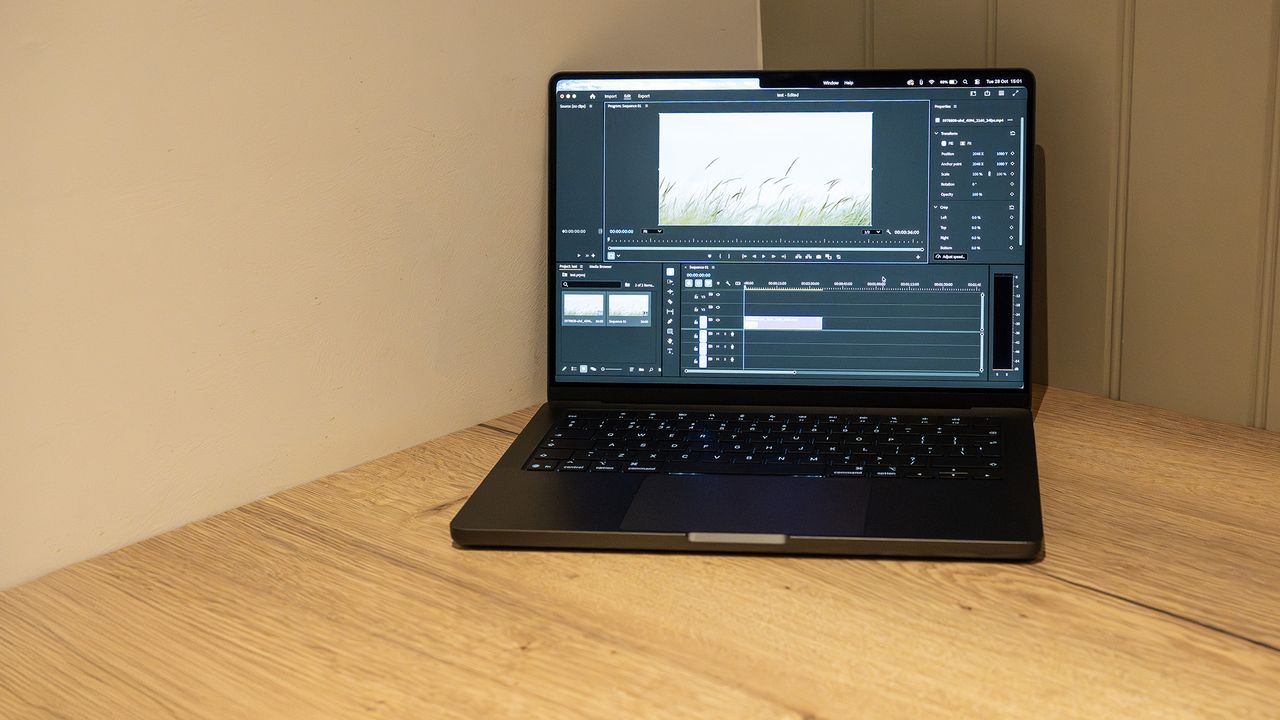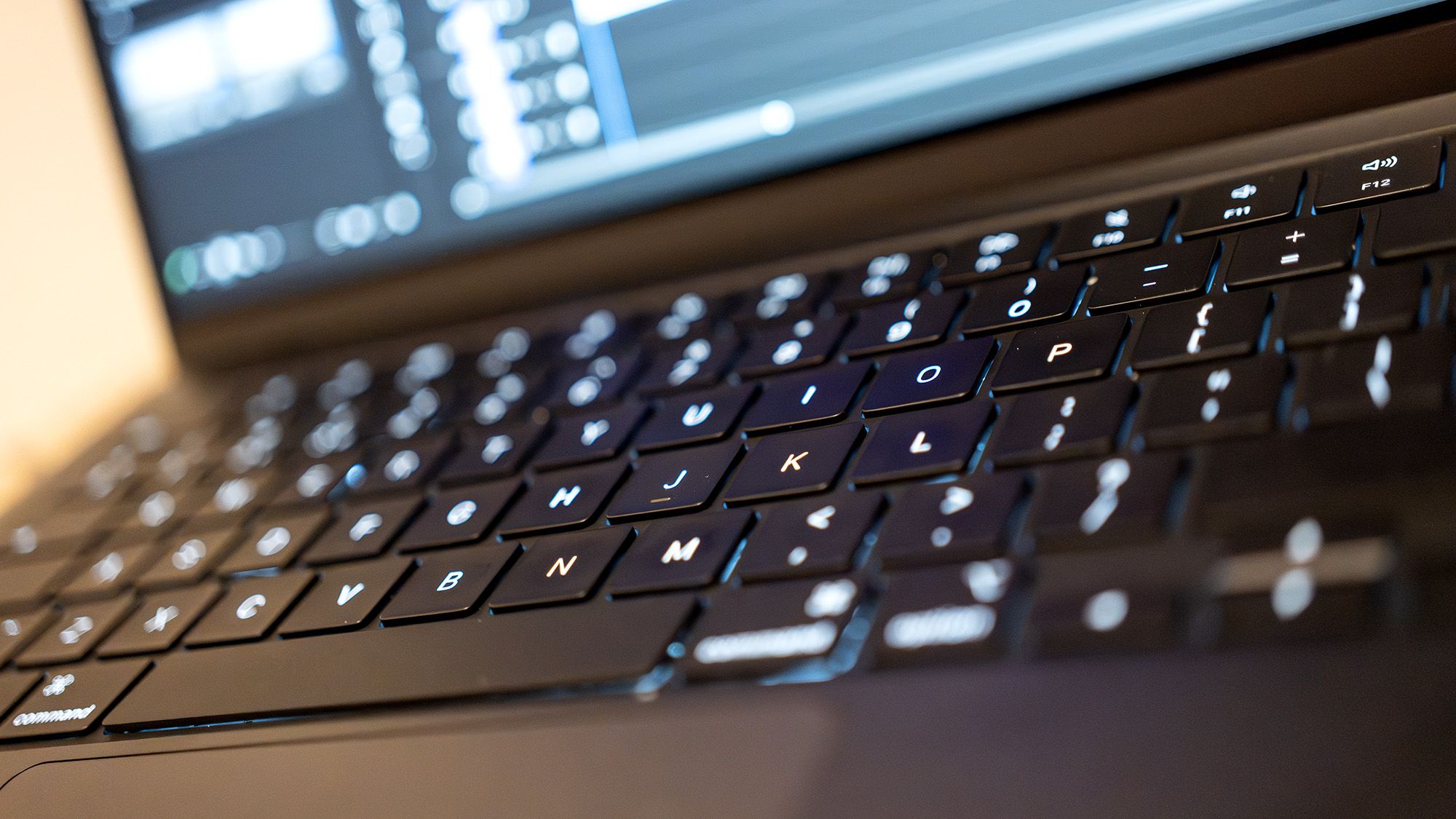
Why you can trust Creative Bloq
Our expert reviewers spend hours testing and comparing products and services so you can choose the best for you. Find out more about how we test.
Opening up a new MacBook Pro is always exciting. Especially as every year now we get a new processor too. For 2025 Apple has produced the M5, a CPU which looks broadly the same as the M4, just a little bit faster and with a bit more memory bandwidth. As these things were already very well developed in last year’s chip, what we get in the M5 is what Apple claims is the world’s fastest processing core, along with graphics and neural processing upgrades that should interest anyone who needs one of the best laptops for Photoshop or Premiere Pro.
It’s the usual beautifully packaged presentation from Apple too, with packaging as nice as a cardboard box can be. It’s not cheap, though, and you’ll have to order a charger separately if you need one, however, as there’s not one in the box by default. That’ll cost you £59 for the 70W and £79 for the 96W, so bear that in mind.
Key specifications
Swipe to scroll horizontallyKey specs
CPU:
Apple M5 (10-core)
NPU:
Apple Neural Engine (16-core)
Graphics:
Integrated (10-core)
Memory:
32GB
Storage:
4TB SSD, SDXC slot
Screen size:
14in
Screen type:
Liquid Retina XDR (IPS)
Resolution:
3024×1964
Refresh rate:
120Hz
Colour gamut (measured):
93% P3
Brightness (measured):
300 nits
Ports:
3x Thunderbolt 4, 1x HDMI, 1x MagSafe 3, 1x 3.5mm audio
Wireless connectivity:
Wi‑Fi 6E, Bluetooth 5.3
Dimensions:
15.5 x 221 x 313mm
Weight:
1.55kg
Design, build and display
(Image credit: Future / Ian Evenden)
• Solid aluminium build
• No changes from last year
If you’re used to the MacBook Air or any of the current crop of thin and light laptops, the MacBook Pro can feel almost chunky. That’s not to say it’s unwieldy – the 14-inch form factor still gets you a decent screen in a chassis that will slip easily into a bag, but it’s a decent lump of metal to carry with you.
And it needs to be, as with the extra size and built-in fan it’s a step up in power over the passively cooled Air, an M5 version of which hadn’t been announced as the Pro landed on CB Towers’ doorstep.
There’s no change over last year’s MacBook Pro, with the same number of Thunderbolt ports in the same places and a lot of the same build-to-order options. It’s got Apple’s weird unmarked fingerprint reader at the top right of the keyboard – a key that’s perfectly functional yet somehow feels less refined than its equivalent on older iPads and iPhones – and there are speakers alongside the keyboard rather than trying to squeeze in a numpad.
It’s such a successful design that there’s little question over why Apple has stuck with it. It’s not flashy – the keyboard has a simple white backlight and the logo on the lid hasn’t lit up for years – yet perfectly functional. It’s everything a pro laptop should be, even if some of the features are starting to show their age.
Daily design news, reviews, how-tos and more, as picked by the editors.
Design score: 4/5
Features
(Image credit: Future / Ian Evenden)
• Very fast SSD
• Only Thunderbolt 4
The inclusion of Thunderbolt 4 in a new MacBook Pro must come as something of a surprise given Thunderbolt 5 started to appear in the M4 generation. It’s still plenty fast, of course, and having three of the multifunctional ports alongside a dedicated MagSafe charging slot means you’ll probably never run out, especially with the excellent range of Thunderbolt docks available, but having last-gen tech on a MacBook Pro just feels a bit wrong.
The same is true of having Wi-Fi 6E instead of Wi-Fi 7, which the latest iPhones and iPads use. There’s no noticeable difference in use between them, you won’t be sitting there complaining that your internet connection is unusable because of it, but again it’s not the latest and greatest thing.
Inside, alongside the M5 (which is very much the latest and greatest thing, at least until Ultra and Max versions come along, with its ten cores split between four performance and six efficient versions) you get at least 16GB of RAM with increased bandwidth over last year’s offering (and boosting this should be your first stop on the build-to-order page as it’s shared between the CPU and GPU) as well as a 512GB SSD (our review laptop had the 4TB upgrade here, which adds a lot to the cost) which now runs at speeds over 6,000MB/s, or almost twice as fast as the M4 model’s. It’s a significant upgrade if you’re shunting a lot of data back and forth, though SSDs were already fast enough that you won’t see a great deal of difference in app loading times.
The screen is Apple’s Liquid Retina XDR, which means IPS. The longed-for OLED upgrade still hasn’t appeared, though Apple’s choice of screen is still excellent, with enough brightness, excellent colour reproduction, and a matte finish that beats OLED’s major drawback, its reflectiveness. That goes for the aluminium casing all over, as while it does still attract greasy fingermarks and dust, it’s not as bad as some other laptops.
Feature score: 3/5
Benchmark scores
(Image credit: Future / Ian Evenden)
We test every one of our laptops using the same benchmarking software suite to give you a thorough overview of its suitability for creatives of all disciplines and levels. This includes:
• Geekbench: Tests the CPU for single-core and multi-core power, and the GPU for the system’s potential for gaming, image processing, or video editing. Geekbench AI tests the CPU and GPU on a variety of AI-powered and AI-boosted tasks.
• Cinebench: Tests the CPU and GPU’s ability to run Cinema 4D and Redshift.
• UL Procyon: Uses UL Solutions’ Procyon software suite to test the system’s ability for AI image generation in Stable Diffusion, its Microsoft Office performance and its battery life in a looping video test.
• Topaz Video AI: We use Topaz Video AI to test the system’s ability to upscale video and convert video to slow-motion.
• PugetBench for Creators: We use the PugetBench for Creators benchmarking suite to test the system’s ability to run several key tasks in Photoshop and Adobe Premiere Pro, as well as its performance when encoding/transcoding video.
• ON1 Resize AI: Tests the system’s ability to resize 5 photos to 200% in a batch process. We take the total time taken to resize the images and divide by 5.
Performance
(Image credit: Future / Ian Evenden)
• Exceptional CPU performance
• GPU still playing catchup in video tasks
Apple’s claims about the M5 containing its fastest processing core are born out by testing. In the graphs somewhere on this page you’ll see that Apple machines occupy the top five slots (at the end of 2025, anyway) in Geekbench’s single-core test results, with the M5 on top and the HP Omen Max 16’s Intel Core Ultra 9 275HX representing Windows in 6th place. That’s exceptional work from Apple’s silicon team, which is putting out a new chip every year and getting strong gains with each revision.
A big jump this year comes from the M5’s GPU, which puts on 10,000 points in Geekbench’s graphics tests over the M4 and now sits between an integrated Intel GPU like that in the Honor MagicBook Pro 14 and the discrete Nvidia chip in something like the Acer Predator Helios Neo 16 AI. It’s not a dedicated gaming chip, though Apple has made much of the release of Cyberpunk 2077 on Mac and the ray-tracing abilities of the M5 GPU, but it can hold its own, producing 60fps in the game if you set RT to low and use the upscaling and frame-gen tricks of the Metal graphics API mixed with AMD’s FSR.
All this means it’s excellent at the kind of graphics creatives specialise in. In Photoshop, the M5 MacBook Pro sits at the top of the ratings for our Pugetbench tests by quite some margin – unless you’re reading this in the future and the M6 has long knocked it off, of course. The same isn’t quite true of Premiere Pro, where Windows machines with thumping great GPUs show their worth by churning through moving pictures more quickly, but it’s ahead of anything using integrated graphics.
Apple’s decision to put neural accelerators in the M5’s GPU cores alongside the M-chips’ dedicated NPU has paid off in AI tests, with the Apple chip coming in close behind budget Nvidia cards in single and half precision, but streaking ahead in the quantised results that evaluate performance in real-world applications where speed and power efficiency are prioritised, such as facial recognition or voice assistants.
Apple is claiming 24 hours of battery life from the M5 laptop, and while that’s very optimistic, real-world usage is still surprising. Thanks to the low-power mode it’s possible to open the laptop with 100% charge and work for half an hour in a web app without it dropping at all. This naturally drops performance – it loses more than half its score in Geekbench’s single-core test – but extends battery life if you’re working on tasks that don’t require full power.
Performance score: 5/5
(Image credit: Future / Ian Evenden)
Price
The MacBook Pro has never been a cheap laptop, but you can get on board for less than you might think. While the latest M5 ones start at £/$1,599, our test unit comes in at a slightly more faint-worthy £/$3,199. Once you start adding extras – the 4TB SSD in our review model comes with a particularly egregious price tag attached – the cost jumps up, and you’re going to want as much RAM as you can squeeze in, as this can’t be added over Thunderbolt.
Value score: 3/5
Who is it for?
• Creative professionals
This is the laptop you want if you’re working on creative projects all day. Video and 3D pros might look for something with a bit more GPU, but for everyone else it’s an easy laptop to work with, and fits nicely into any professional life.
Swipe to scroll horizontallyApple MacBook Pro M5 score card
Attributes
Notes
Rating
Design:
Looks like a MacBook Pro, nothing wrong with that.
4/5
Features:
Needs a Thunderbolt and Wi-Fi upgrade.
3/5
Performance:
Extremely fast CPU results.
5/5
Value:
Not the cheapest laptop, and upgrades push it sky-high.
3/5
(Image credit: Future / Ian Evenden)
Buy it if…
- You want screaming CPU performance
- A reliable professional laptop is on your shopping list
- You aren’t a Windows fan
Don’t buy it if…
- You need more GPU capability
- Or something thinner and lighter
- MacOS turns you off
Also consider
With its cutting-edge components and compact frame, the Acer Predator Triton 14 AI looks like a creative powerhouse, and it can be exactly that. There’s even a stylus in the box.
Microsoft
Surface Laptop 7
With the Microsoft Surface Laptop 7, Microsoft needed to show the world that Copilot+ and the new Snapdragon processors weren’t just a load of hot air. And it has managed it. The MacBook is no longer the only ARM-powered productivity laptop we can recommend.
Acer
Predator Helios Neo 16 AI
With the latest in CPU and GPU technology, this is a laptop that is built for even the most demanding of creative workflows.
